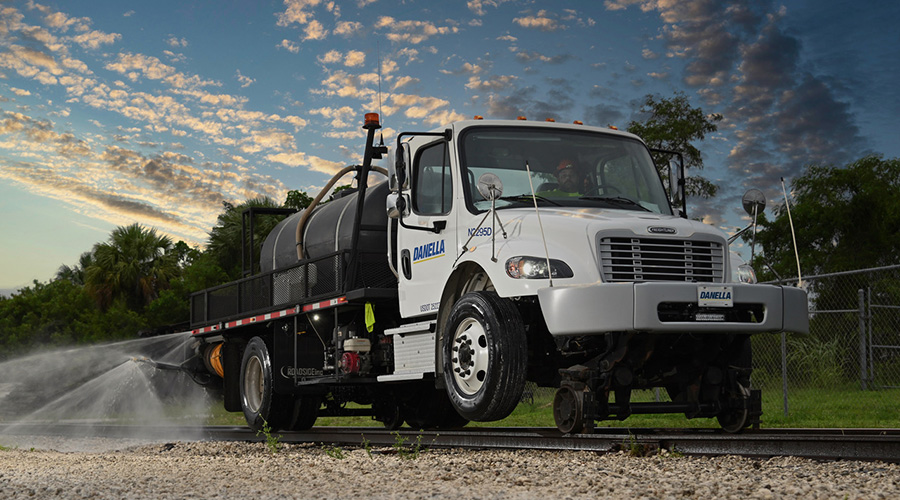Stay updated on news, articles and information for the rail industry
December 2008
Part 1 : INTRO: Railroad Contractor Case Studies
Part 2 : PART 1: All Railroad Services Completes Complex 'Slip-Slide' Project for Long Island RailRoad
Part 3 : PART 2: L.A. Colo Comes Through in the Cold for Iowa, Chicago & Eastern
Part 4 : PART 3: Mass. Electric Makes the Grade at 52 Crossings for North Coast Railroad Authority
Part 5 : PART 4: RailWorks Track Systems Does it's Part to Keep Prairie State Energy Campus Project on Track
Rail News: MOWPART 4: RailWorks Track Systems Does it's Part to Keep Prairie State Energy Campus Project on Track
The $4 billion, 200-acre Prairie State Energy Campus will be one of the largest, most energy-efficient coal-fueled power plants in the United States when it’s completed in 2011 or 2012. Currently under construction, the Lively Grove, Ill., campus will generate up to 1,600 megawatts of energy for more than 1.7 million households. To meet stringent environmental standards, it’ll emphasize the use of clean-coal-burning technology. It also will have its own coal mine that produces up to 6 million tons annually.
“It’s a cool job,” says Brian Bennett, vice president and regional manager-Southeast Region for RailWorks Track Systems Inc., the general contractor responsible for track infrastructure, bridgework and earthwork for the power plant and coal mine. “There aren’t a lot of power plants that have been built over the last 20 years. We’re happy to be part of it.”
As of press time, the RailWorks Corp. subsidiary was nearing completion on the first of a three-phase rail, bridge and earthwork project.
The contractor is performing the trackwork, grade crossing and signal construction work, furnishing all track materials, and managing the subcontractors performing the earthwork and bridge construction.
A Three-Phased Journey
Phase I — an “expedited phase,” as RailWorks officials put it — began in January 2008 when the contractor’s crews set out to complete the earthwork to prepare the construction site, and build the rail connection and related crossings and signals from the Canadian National Railway Co. mainline to the plant site.
Completing the work by Jan. 15, 2009, is critical: The CN link will enable building construction materials to be moved closer to the main plant by rail, Bennett says. In addition to managing the earthwork, design and superstructure of the bridge construction, RailWorks constructed 21,000 feet of track, as well as the decking on each of the three railroad bridges.
Aside from contending with occasional weather delays, RailWorks has had to take the unusual step (in the Midwest, anyway) of ensuring the bridge and rail construction and installation met earthquake standards; the plant’s in a seismic zone, Bennett says.
Phase I’s tight timeframe and large scope of work — from laying rail to building bridges and crossings — also required RailWorks crews to do a fair amount of multi-tasking. In addition, RailWorks had to coordinate work with the main contractor, Bechtel Power Corp., along with other contractors, and the various state and federal regulatory agencies involved in site development.
The six-month Phase II project is scheduled to begin in January 2009, with RailWorks crews spending most of their time building track. Work on Phase III, which will begin sometime in spring 2009, involves completing plant track infrastructure, including an 18,350-foot double-loop track with 11 #10 turnouts for unit trains.
Ultimately, the project represents “another big stepping stone that proves to a lot of people that we’re more than just a good ole’ railroad contractor,” Bennett says. “We’ve got the staff and the expertise to manage projects like this.” 
— By Robert J. Derocher
Keywords
Browse articles on rail contractor railroad contractor RailWorks maintenance of wayContact Progressive Railroading editorial staff.


 2025 MOW Spending Report: Passenger-rail programs
2025 MOW Spending Report: Passenger-rail programs
 Gardner steps down as Amtrak CEO
Gardner steps down as Amtrak CEO
 Guest comment: Oliver Wyman’s David Hunt
Guest comment: Oliver Wyman’s David Hunt
 Women of Influence in Rail eBook
Women of Influence in Rail eBook
 railPrime
railPrime






